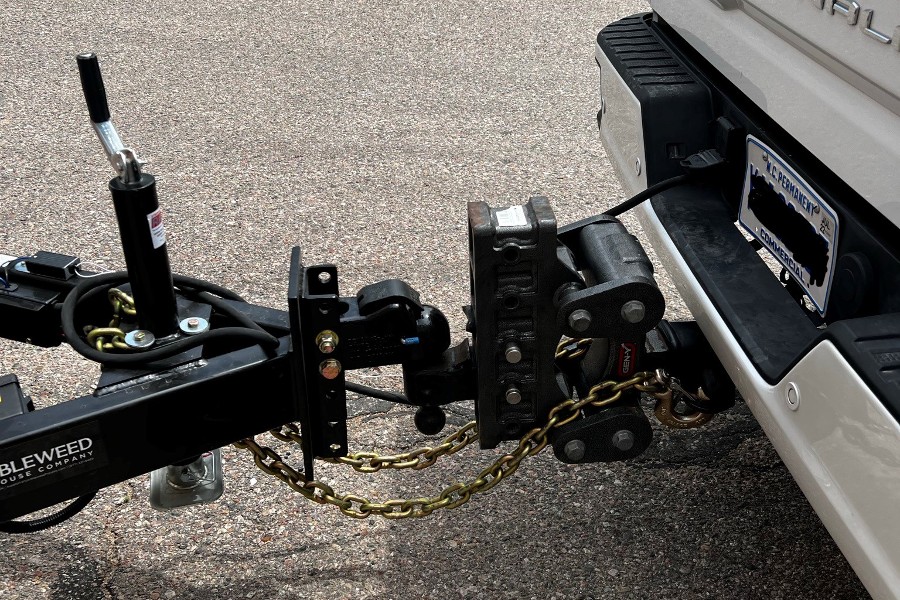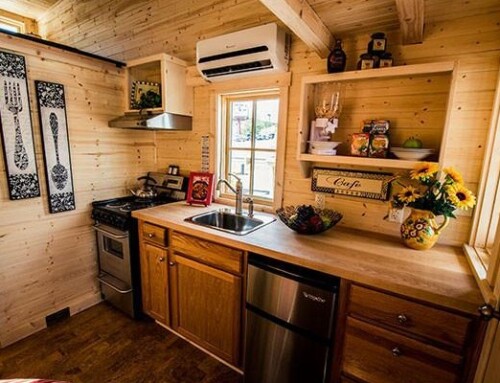Traveling in style with a tiny home RV is a great option for people who need to move frequently or are unsure of how long they will stay in one place. Enjoy a flexible living situation that can be taken with you wherever your job or duties require you to go.
But let’s be real. You can’t just pick up a tiny house and go. You need to know how to move it. That’s why it’s important to make sure you’ve got all your ducks in a row before you roll out.
Preparation and planning are paramount before towing your tiny house RV, as it can be intimidating for those who have never done it before.
In this article, we will provide you with the information you need to tow your tiny house safely and successfully while enjoying your travels.
Steps to Tow Your Tiny Home Like A Pro
Safety First
First things first, let’s talk about safety. Before you even think about setting off with your tiny house RV, you need to confirm the towing safety numbers for both your tiny home RV and your towing vehicle. Don’t worry, it’s not rocket science—just check the Tumbleweed data plate (in the closet) or the sticker on the tongue. In most trucks, you can find all the info you need in the owner’s manual or on the driver’s side door jamb.
You will need the following 5 weight ratings:
- The dry weight of your tiny house RV
- The tongue weight of your tiny house RV
- The empty weight of your tow vehicle
- The GCVW (gross combined vehicle weight) of your tow vehicle
- The tongue weight capacity of your tow vehicle

It’s crucial to make sure that all of these numbers are within the recommended range to avoid any accidents or mishaps while towing. Trust me, you don’t want to skimp on this step. If you load your towing vehicle with more weight than it’s rated for, let’s just say you will be pretty dissatisfied with the outcome when you hit the road.
First, make sure that the tongue weight capacity of your tow vehicle is (5) MORE THAN the tongue weight of your tiny house RV (2)
Second, confirm that your truck can safely pull the tiny house. The GCVW (4) must be MORE THAN the dry weight of your tiny house RV (1) plus the empty weight of your tow vehicle (3)
Prepare for Departure
Now that we’ve got the boring stuff out of the way, let’s move on to the fun part – preparing your Tumbleweed tiny house for the journey.
Close and lock all windows and skylights, secure loose items, and disconnect the power cord, water hoses, sewer lines, and cable/internet connections. Shut off the main breaker in the electrical panel and empty the water tank, making sure the water tank drain is closed. You don’t want anything water or bugs getting in through a crack while on the road.
The Hookup
Next, it’s time to get your tiny house RV hooked up to your towing vehicle:
- First, make sure your tow vehicle is strong enough to pull that tiny house of yours as instructed above.
- Next up, install a proper tow ball mount on your truck and add some trailer wheel chocks to keep everything in place. Retract the stabilizer jacks on your RV and use the manual hitch crank to raise the trailer hitch above the tow ball.
- Align the tow ball and lower the hitch onto it using the manual hitch jack handle. And don’t forget to connect those safety chains, the trailer’s electrical umbilical cord, and the breakaway cable to your tow vehicle.

Alright, we’re almost ready to take to the streets!
Testing, Testing, Testing
So you’ve hooked up your tiny house RV to your tow vehicle, and you’re ready to embark on your adventure. But before you do, it’s crucial to test all the lights and brakes to make sure everything is working as it should. Have one person stand behind the tiny house RV while the other person hits the brakes and activates the turn signals.
You should see the lights on the tiny house RV come on and hear a loud “hum” coming from each wheel when the brakes are applied. If everything looks and sounds good, you’re good to go! Don’t forget to double-check everything before leaving. You don’t want any surprises on your trip, and you definitely don’t want to be driving down the highway without the tiny house RV brakes connected.
Finally Underway
Finally, you can get on the road—just drive safely. But sometimes unexpected things happen that make the journey longer or more tedious. A common problem is a flat tire, a simple issue like that can cause a lot of frustration. Make sure you check out: How to Change a Flat Tire on Your Tiny House RV, to be on top of the situation.
Having chosen your destination, make sure you know the laws in the state you’re in, and the provisions for where to park a tiny house. If you’re staying at an RV park, follow the rules. And if you’re parking on someone else’s property, get permission first and be a good neighbor. Park properly to save yourself and your neighbors any stress or heartache.
Here are excellent tips and info on how and where to park a tiny house when you get to your desired location: How to Park Your Tiny House.
Cost of Towing A Tiny House
The cost of towing a tiny house RV depends on several factors, including
- The distance you need to travel, and
- Whether you hire a professional towing company or do it yourself.
If you use a professional company, you can expect to pay anywhere from a few hundred to several thousand dollars, depending on the distance and any additional services you may need.
If you plan on doing the towing yourself, you’ll need to consider the cost of fuel for your tow vehicle, as well as any necessary repairs or maintenance.
Additionally, you’ll need to factor in any other expenses related to your trips, such as food and entertainment. Jenna and Guillaume traveled over 15,000 miles with their tiny house, and they gave a full breakdown of their monthly expenses in this article: Cost of Towing a Tiny House RV. So go ahead and check it out.
Conclusion
In conclusion, traveling tiny house style, and learning to tow your unique home can be an adventure if you prepare properly. Confirm the towing safety numbers, prep your RV, and hook everything up right. Test the lights and brakes before you set off. And don’t forget to follow the rules and regulations at your destination, know where to park, and look for ways to save money on the journey. Happy towing!








You should add that you need a least a one ton truck
That depends on the size weight of the tiny home. 20′ tiny homes can usually be towed with a 3/4 ton truck.
Always know the height and width of your tiny home and the height restrictions of the highways you might travel on, get a good truckers GPS that shows bridge heights and road widths,as well as weight restrictions of roads and bridges, there are some GPS units out there that are interactive so you can pass on to others what you find and experience, and please respect the space that truckers need to safely operate their vehicles
After following the Tiny House movement for many years, I’ve come to the conclusion that it really makes little sense to limit the idea to a supposed RV–and to therefore limit the share footage. There are so few options for where to park them. They’re always shown in some idyllic meadow or mountain area, but in reality, most states won’t allow them even on privately owned lots/land. If you park on DNR land, you have to be totally off grid. Also, as the size of these things grows (triple axle, two story), they are almost impossible to move yourself and still pretty small to live in full time. They end up being pricy Air B&B’s in specially zoned “villages” or sometimes in people’s driveways. I manage an RV Park and we have a maximum sized one here on our only site large enough to hold it, and it cost several hundred dollars to move it here from a short distance away. It’s a very rural community, but tiny homes are too small to be allowed on private lots, even with septic system in place. You can have one on your property as an RV, but you are not allowed to live in it as a residence–same as a trailer.
I find myself more interested in the cottage concept, a small house that meets average zoning requirements, very well-designed, and affordably built. It’s easier to get a variance for a cluster of cottages with smaller than usual square footage (say 500 – 1,000 sq ft) than to get permission for tiny houses on lots ( which tend to end up cluttered with all sorts of sheds and such because they are, well—too small.
I notice when watching videos about tiny houses that many people are quite secretive about where they park them. It’s usually vaguely about being lucky to put it on some friend or relatives large acreage (where the legality of such is very likely in question). I’m sure there are places in the US where all of the above is not true, so I’ll say that I live in the Pacific Northwest and I have not yet been able to find a place where I can legally park and occupy a tiny house on a privately owned piece of land.
This would b a lot better for a novice like myself if you gave the label abbreviations for dry weight and tongue weight and if the Cost of Towing a Tiny House RV worked.
I appreciate your very honest comment. Parking a tiny home doesn’t seem to have gotten any easier over the years as was originally hoped. I see the encampments of broken-down RVs that collect on our city streets and suspect that has something to do with it.
You left out 2 important issues: the potential need for trailer brakes and your trailer tires!!
Trailer brake assist:
1) If your trailer didn’t come with one, for example if you built your own house on a trailer you bought separately, you need to install one (presumably commercially built houses have one on their trailer)
2) If you need that and don’t have it your vehicle brakes could overheat and fail.
Tires:
1) The obvious is to check tire pressure.
2) Rubber tires get dry rot over time. Make sure yours aren’t “expired”. Generally tires need replaced after 6 or 7 years regardless of the tread depth due to dry rot..
3) Tires, where you haven’t moved your house at all for extended periods of time, can have problems based on that. Besides going flat they can warp, get flat spots, or get tiny bubbles, some of which may not be visible. You need to be taking care of your tires while your trailer is parked (for example having them covered, or even propping up the trailer so there is no weight on the tires. Also making sure they are covered.
4) It is incredibly dangerous to drive on dry rotted, warped, tires with flat spots, etc. tires. Your vehicle will harder to control when your trailer has a flat while on the highway (or elsewhere).
Great article! I never thought towing a tiny home could be so straightforward. The five steps you provided are incredibly helpful for anyone looking to tow their tiny home like a pro. Starting with the weight distribution tips, it’s crucial to ensure safety on the road. The checklist you provided will definitely come in handy to avoid any mishaps. The advice on choosing the right towing vehicle and getting the necessary permits is invaluable. I appreciate the emphasis on practicing towing skills and understanding the limitations of your vehicle. Overall, this article is a comprehensive guide that simplifies the process of towing a tiny home. Thank you for sharing these essential steps!